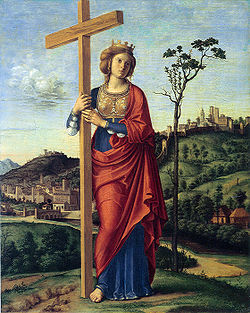Two Wine Country Locations and a Saint From Ancient Rome
Mount St. Helena in Sonoma County was named some 15 years before the city in Napa received the same name in 1855.
The town, apparently, got its name from the local Sons of Temperance who called themselves the “St. Helena Chapter” after the mountain at the head of the valley.
According to Saints of California: A Guide to Places and Their Patrons, the mountain was likely so named by the Russian settlers at Fort Ross to commemorate the visit of the ship, St. Helena, to California in 1841.
Far less likely, say the authors, is a Russian princess named Helena planting the homeland’s flag atop the 4,342-foot summit.
The plaque left by the 1841 surveying party does include the name Princess Helena de Gagarin, wife of Count Alexander G. Rotchev, the commanding officer of Fort Ross, according to the California Genealogy and History Archives.
St. Helena is the mother of Emperor Constantine I who may or may not have been a Christian but under whose reign ended persecution of the church and its members and returned property seized by his predecessor, Diocletian, who unleashed the most virulent attack on Christians in Roman history.
It’s also not clear whether Helena, who St. Ambrose describes as a “stable maid” or “innkeeper,” was married to Constantine’s father, Constantius, or his concubine. Either were acceptable social arrangements in ancient Rome.
The two separated or divorced sometime before 289 so Constantius could advance his career by marrying the emperor’s daughter, Theodora.
 Flavia Iulia Helena was born around 248, most likely in Drepanum in Bithynia, modern north-central Turkey. The city was renamed Helenopolis by her son who was probably born around 270.
Flavia Iulia Helena was born around 248, most likely in Drepanum in Bithynia, modern north-central Turkey. The city was renamed Helenopolis by her son who was probably born around 270.
During Constantine’s youth, there were two co-emperors – one of the eastern and one of the western parts of the empire. Each emperor had a caesar. Constantius was the caesar of the western emperor.
Constantine fought with his father in Gaul and Britain, including some forays above Hadrian’s Wall to attack Picts, modern day Scots.
After his father’s death, Constantine declared himself emperor of the west and, using his father’s army to back up the claim, engaged in a series of battles with the co-emperor and his caesar to become sole emperor.
His victory was secured at the Battle of the Milvian Bridge on the Tiber where he beat the armies of co-emperor Maxentius, whose fleeing soldiers knocked him into the river where he drowned.
Prior to the battle, Constantine claimed to see a vision – or later church historians say he did – that, in the most widely circulated version, is of the “Chi-Rho,” one of the first Christian symbols of Jesus’ name. The combination of Greek letters looks like a “P” with an “X” through the middle of its tail.
Constantine was told that using this symbol he would prevail.
After he took the throne, Helena returned to his court.
In 326, she journeyed to the Holy Land, supposedly aiding in the construction or rehabilitation of two churches – that of the nativity in Bethlehem and that on the Mount of Olives overlooking Jerusalem.
At the time, Jerusalem was rebuilding after its sack by Hadrian.
According to church lore, Helena ordered a temple to Roman gods built by the former emperor over Jesus’ tomb to be torn down. She ordered excavations made of the area and, supposedly, found three crosses.
Wanting proof as to which was the True Cross – “Santa Cruz” in Spanish – Helena brought a woman near death to Jerusalem and had her touch each one. She revived after touching the third.
Constantine ordered the Church of the Holy Sepulcher built on the spot.
Legend has it Helena also found the nails of the crucifixion. To help her son, she had one mounted on his helmet and another on the bridle of his horse.
She returned home with her relics in 327 and died in 330 at the age of 80.
Because of her dsicovery of the true cross, she is usually portrayed in church art holding one.
Helena is the patron saint of archaeologists.
-30-
Filed under: California History
Capitol Cliches Conversational Currency Great Moments in Capitol History News Budget and Economy California History Demographics Fundraising Governor Legislature/Legislation Politics State Agencies
Opinionation Overheard Today's Latin Lesson
Restaurant Raconteur Spotlight Trip to Tokyo Venting Warren Buffett Welcome Words That Aren't Heard in Committee Enough

\"The town, apparently, got its name from the local Sons of Temperance who called themselves the “St. Helena Chapter” after the mountain at the head of the valley.\" — isn\’t that incredibly convoluted? It seems more likely that the town would have named itself after the mountain, and the chapter named itself after the town.
Comment by Minivet — 2.11.2011 @ 1:58 pm
Does seem convoluted but couldn’t find any other explanations of its origin in source materials. Stranger things have happened. xoxox
Comment by admin — 2.14.2011 @ 12:34 pm